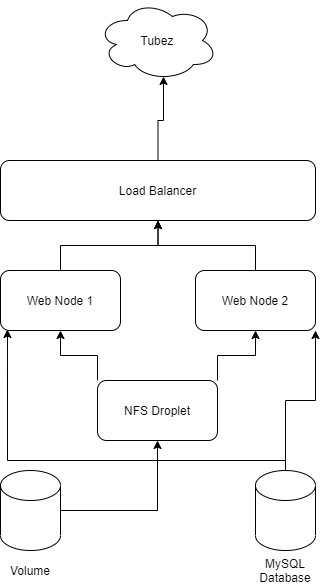It seems no one has written a blog post on creating dynamic inventory scripts for Ansible in a while. I feel this topic could use an update as some of the information I found was incomplete or out of date.
My goal is was convert Terraforms’s tfstate data from DigitalOcean to a usable inventory script. Keep that in mind as it drove many specifics on how the script works. I want to also note that the script I reference is a first pass at getting a working inventory script.
So first, the script (in its current state):
#!/usr/bin/python3
import subprocess
import argparse
import json
relevant_tf_state_values = {
'digitalocean_droplet': ['name', 'ipv4_address', 'ipv4_address_private', 'tags'],
'digitalocean_database_cluster': ['name', 'host', 'private_host', 'port'],
'digitalocean_database_user': ['name', 'password'],
'digitalocean_database': ['name'],
'digitalocean_domain': ['id'],
'digitalocean_volume': ['name', 'size', 'initial_filesystem_type'],
'digitalocean_ssh_key': ['name', 'fingerprint']
}
extra_vars = {
'ansible_ssh_user': 'root',
'web_mount_point': '/mnt/nfs/data',
'web_mount_point_type': 'nfs',
'ansible_ssh_common_args': '-o StrictHostKeyChecking=no -o userknownhostsfile=/dev/null'
}
class DigitalOceanInventory(object):
def __init__(self):
self.tags = []
self.droplets = []
self.vars = {}
self.inventory_json = json.loads(self._get_terraform_output())
self._generate_groups()
self._generate_vars()
self.ansible_inventory = self._generate_ansible_inventory()
def _get_terraform_output(self):
process = subprocess.Popen(['terraform', 'show', '-json'],
stdout=subprocess.PIPE,
stderr=subprocess.PIPE,
universal_newlines=True)
stdout, stderr = process.communicate()
return stdout
def _parse_resource(self, resource, resource_type, relevant_objects):
data = {}
for key, value in resource['values'].items():
if key in relevant_objects:
data[f'{resource_type}_{key}'] = value
return data
def _generate_groups(self):
tags = 'digitalocean_tag'
droplets = 'digitalocean_droplet'
for resource in self.inventory_json['values']['root_module']['resources']:
if resource['type'] == tags:
self.tags.append(resource['values']['name'])
elif resource['type'] == droplets:
self.droplets.append(self._parse_resource(resource, droplets, relevant_tf_state_values[droplets]))
def _generate_vars(self):
for resource in self.inventory_json['values']['root_module']['resources']:
if resource['type'] in relevant_tf_state_values.keys() and resource['type'] not in \
['digitalocean_tags', 'digitalocean_droplets']:
for key, value in resource['values'].items():
if key in relevant_tf_state_values[resource['type']] and key not in ['ip', 'tags']:
resource_id = resource['type']
self.vars[f'{resource_id}_{key}'] = value
for key, value in extra_vars.items():
self.vars[key] = value
def _generate_ansible_inventory(self):
inventory = {}
for tag in self.tags:
hosts = []
public_ips = []
private_ips = []
inventory[tag] = {}
for droplet in self.droplets:
if tag in droplet['digitalocean_droplet_tags']:
hosts.append(droplet['digitalocean_droplet_ipv4_address'])
public_ips.append(droplet['digitalocean_droplet_ipv4_address'])
private_ips.append(droplet['digitalocean_droplet_ipv4_address_private'])
inventory[tag]['hosts'] = hosts
inventory[tag]['vars'] = self.vars
ansible_tag = tag.replace('-', '_')
inventory[tag]['vars'][f'{ansible_tag}_public_ips'] = public_ips
inventory[tag]['vars'][f'{ansible_tag}_private_ips'] = private_ips
if 'digitalocean_volume_name' in inventory[tag]['vars']:
nfs_mount_point = str('/mnt/' + inventory[tag]['vars']['digitalocean_volume_name'].replace('-', '_'))
inventory[tag]['vars']['nfs_mount_point'] = nfs_mount_point
inventory['_meta'] = {}
inventory['_meta']['hostvars'] = {}
return inventory
def get_inventory(self):
return json.dumps(self.ansible_inventory, indent=2)
def main():
parser = argparse.ArgumentParser()
parser.add_argument('--save', '-s', help='Generates Ansible inventory and stores to disk as inventory.json.',
action='store_true')
parser.add_argument('--list', action='store_true')
args = parser.parse_args()
do = DigitalOceanInventory()
if args.list:
print(do.get_inventory())
elif args.save:
with open('inventory.json', 'w') as inventory:
inventory.write(do.get_inventory())
if __name__ == '__main__':
main()
At a high level, we’re getting the tfstate from Terraform by running the following command: terraform show -json. Next, we generate hostgroups by piggybacking on the tags added to host resources during creation. Next, we parse through the other resources to get the subset of information that we’re interested in. Finally, we generate an Python object with all the data in the desired format. Finally, we dump it as a JSON object and either return it to stdout or to inventory.json.
The inventory output looks something like this:
{
"tag-name-node": {
"hosts": [
"10.0.0.1"
],
"vars": {
"digitalocean_ssh_key_fingerprint": "00:11:22:33:44:55:66:77:88:99:AA:BB:CC:DD:EE:FF",
"digitalocean_ssh_key_name": "sshkeyname",
"ansible_ssh_user": "root",
"web_mount_point": "/mnt/nfs/data",
"web_mount_point_type": "nfs",
"ansible_ssh_common_args": "-o StrictHostKeyChecking=no -o userknownhostsfile=/dev/null",
"digitalocean_database_cluster_host": "something.ondigitalocean.com",
"digitalocean_database_cluster_name": "db-name",
"digitalocean_database_cluster_port": 25060,
"digitalocean_database_cluster_private_host": "private.something.ondigitalocean.com",
"digitalocean_database_user_name": "wordpress",
"digitalocean_database_user_password": "password",
"digitalocean_domain_id": "something.com",
"digitalocean_volume_initial_filesystem_type": "ext4",
"digitalocean_volume_name": "volume-name",
"digitalocean_volume_size": 5,
"nfs_node_public_ips": [
"10.0.0.1"
],
"nfs_node_private_ips": [
"10.0.0.1"
],
"nfs_mount_point": "/mnt/barista_cloud_volume"
}
},
"_meta": {
"hostvars": {}
}
}Now, if you try to feed this to Ansible as an inventory file, it will not be parsed correctly. The dynamic inventory JSON format is not the same as the JSON inventory format. This took me awhile to figure out and is honestly kind of frustrating as it makes creating a working JSON template so you can iterate and test quickly much more difficult than it needs to be. On the topic of gotcha’s, here a a few more to be aware of.
- Your inventory script does not have to be written in Python, but it must include a shebang at the top of the script so it can be executed (also it must be executable so
chmod +xyour script). - The inventory script must accept the flag
--list. It’s supposed to also accept--hostand return details on a single host but I have not needed it nor implemented it. - Even if you are not adding vars for specific hosts, you MUST include the
_metasection in your inventory.
That’s about it. I will probably come back around and clean this script up and make it more reusable. Heck, I might put together a boilerplate script that can make creating custom dynamic inventory scripts quicker. As mentioned before, this is a first pass attempt to get something that works for my use case.
Finally, I feel I would be remiss if I did not include the tidbits of info I found scattered around the web that helped me figure this out.
https://www.jeffgeerling.com/blog/creating-custom-dynamic-inventories-ansible (Jeff, as always, is an invaluable resource on all things Ansible.)
https://docs.ansible.com/ansible/2.9/dev_guide/developing_inventory.html
https://adamj.eu/tech/2016/12/04/writing-a-custom-ansible-dynamic-inventory-script/
Thanks all folks. Have a good weekend!


